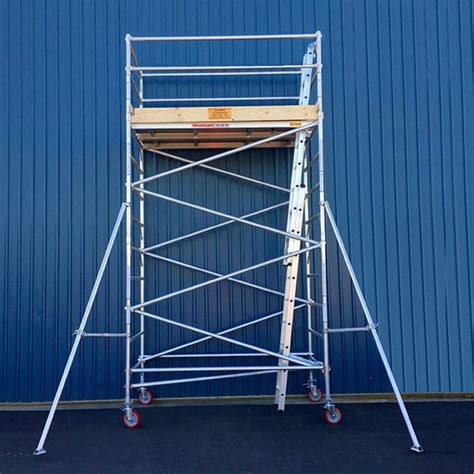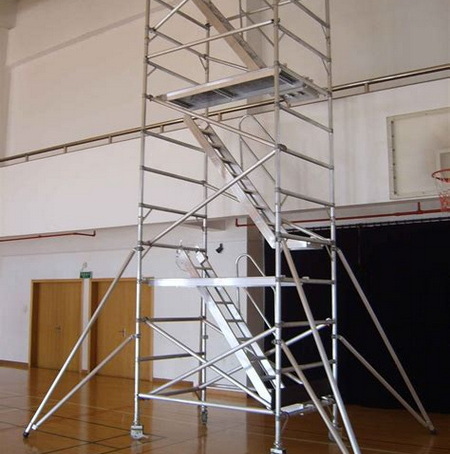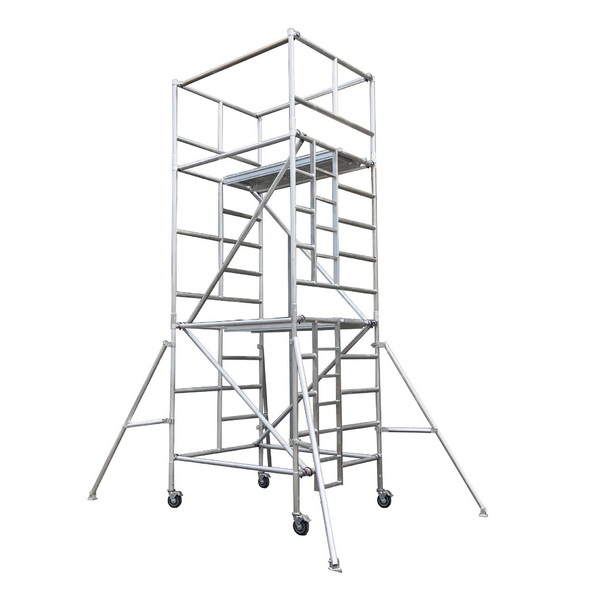Content Menu
● Introduction to Aluminum Mobile Scaffolding Towers
● Key Features of Aluminum Mobile Scaffolding Towers
● Maximum Height of Aluminum Mobile Scaffolding Towers
● Safety Considerations for Height Extension
● Assembly Procedure for Aluminum Mobile Scaffolding Towers
● Safety Regulations and Best Practices
● Advanced Safety Features
● Environmental Considerations
● Maintenance and Repair
● Cost-Effectiveness
● Conclusion
● FAQ
>> 1. What is the maximum height of an aluminum mobile scaffolding tower?
>> 2. What safety features are essential for aluminum mobile scaffolding towers?
>> 3. How often should aluminum mobile scaffolding towers be inspected?
>> 4. What is the recommended base to height ratio for scaffolding towers?
>> 5. Can aluminum mobile scaffolding towers be used indoors and outdoors?
● Citations:
Aluminum mobile scaffolding towers are widely used in construction and maintenance projects due to their versatility, ease of assembly, and safety features. These towers are designed to provide a stable and secure platform for workers at various heights. In this article, we will explore the maximum height that aluminum mobile scaffolding towers can reach, along with safety considerations and assembly procedures.

Introduction to Aluminum Mobile Scaffolding Towers
Aluminum mobile scaffolding towers are preferred for their lightweight yet robust structure, making them easy to transport and assemble. They are commonly used in residential, civil, and construction projects for both short-term and long-term maintenance. These towers feature locking castors and wheels, which enhance mobility and facilitate easy dismantling for transportation.
Key Features of Aluminum Mobile Scaffolding Towers
- Lightweight and Durable: Made from high-quality aluminum, these towers are both lightweight and durable, ensuring they can withstand various environmental conditions.
- Easy Assembly and Disassembly: Equipped with locking castors and wheels, they are easy to assemble, dismantle, and transport.
- Multi-Level Work: They allow for multi-level work, making them versatile for different types of projects.
- Safety Features: Include guardrails, toe boards, and stabilizers to ensure worker safety.
Maximum Height of Aluminum Mobile Scaffolding Towers
The maximum height of aluminum mobile scaffolding towers typically ranges from 10m to 12m. This range is recommended to ensure stability and safety while working at heights. However, some high-quality aluminum scaffold towers can reach heights of up to 14m, but these are generally used for interior work and require additional stability measures.
Safety Considerations for Height Extension
When extending the height of a scaffolding tower, several safety considerations must be taken into account:
- Base to Height Ratio: The stability of the tower is directly related to its base width and height. A wider base provides greater stability.
- Proper Assembly: The tower must be erected correctly, with all safety features in place, such as guardrails and toe boards.
- Regular Inspections: Regular inspections are crucial to ensure that the tower remains stable and secure.
Assembly Procedure for Aluminum Mobile Scaffolding Towers
Assembling an aluminum mobile scaffolding tower involves several steps to ensure safety and stability. Here is a simplified guide:
1. Prepare the Site: Ensure the ground is level and firm.
2. Assemble the Base: Lock the castors and adjust the leveling feet to ensure the base is stable.
3. Erect the Frames: Stand up the base frames and secure them with horizontal braces.
4. Add Platforms: Install platforms at regular intervals, ensuring they are securely attached.
5. Install Guardrails: Add guardrails and toe boards for safety.

Safety Regulations and Best Practices
Safety is paramount when working with scaffolding towers. Here are some key regulations and best practices:
- Competent Supervision: Ensure that a competent person supervises the assembly and use of the scaffolding.
- Risk Assessment: Conduct thorough risk assessments before starting work.
- Proper Training: Ensure all users are properly trained in the assembly and use of the scaffolding.
- Regular Maintenance: Regularly inspect and maintain the scaffolding to prevent wear and tear.
Advanced Safety Features
In addition to the basic safety features, some advanced models of aluminum mobile scaffolding towers include:
- Automatic Locking Systems: These ensure that platforms are securely locked into place.
- Stabilizer Bars: These provide additional stability, especially in windy conditions.
- Anti-Slip Surfaces: Platforms and steps are designed with anti-slip surfaces to prevent accidents.
Environmental Considerations
Aluminum mobile scaffolding towers can be used in various environmental conditions, but certain precautions must be taken:
- Wind Resistance: Ensure the tower is securely stabilized in windy conditions.
- Rain and Snow: Regularly inspect the tower for damage from rain or snow.
- Extreme Temperatures: Be cautious of extreme temperatures that may affect the structural integrity.
Maintenance and Repair
Regular maintenance is crucial to extend the lifespan of aluminum mobile scaffolding towers:
- Regular Inspections: Check for wear and tear, corrosion, or damage.
- Cleaning: Regularly clean the tower to prevent dirt buildup.
- Storage: Store the tower in a dry place when not in use.
Cost-Effectiveness
Aluminum mobile scaffolding towers are cost-effective due to their durability and reusability:
- Long Lifespan: They can withstand multiple uses without significant degradation.
- Easy Transport: Their lightweight nature makes them easy to transport, reducing logistical costs.
- Versatility: They can be used for a variety of tasks, making them a valuable investment.
Conclusion
Aluminum mobile scaffolding towers offer a versatile and safe solution for working at heights. While they can reach heights of up to 12 meters, safety considerations and proper assembly are crucial to ensure stability and worker safety. By following best practices and adhering to safety regulations, these towers can be effectively used in a variety of construction and maintenance projects.

FAQ
1. What is the maximum height of an aluminum mobile scaffolding tower?
The maximum height of an aluminum mobile scaffolding tower typically ranges from 10m to 12m, though some models can reach up to 14m under specific conditions.
2. What safety features are essential for aluminum mobile scaffolding towers?
Essential safety features include guardrails, toe boards, and stabilizers to prevent falls and ensure stability.
3. How often should aluminum mobile scaffolding towers be inspected?
Aluminum mobile scaffolding towers should be inspected regularly to ensure they remain stable and secure, especially after assembly and before use.
4. What is the recommended base to height ratio for scaffolding towers?
While the traditional 3:1 ratio is no longer a strict guideline, a wider base generally provides greater stability for the tower.
5. Can aluminum mobile scaffolding towers be used indoors and outdoors?
Yes, aluminum mobile scaffolding towers can be used both indoors and outdoors, but the maximum working height may vary depending on the environment.
Citations:
[1] https://scaffold-tower-hire.com/maximum-height/
[2] https://www.youtube.com/watch?v=UBVA-LD2IkE
[3] https://patents.google.com/patent/CN104520521A/zh
[4] https://amscaffold.com/sw180-single-width-aluminium-scaffold-tower/
[5] https://www.youtube.com/watch?v=DKdfDonH7GU
[6] https://www.mdpi.com/2071-1050/15/8/6521
[7] https://www.bpsdepot.co.uk/blog/maximum-height-of-scaffold-towers
[8] https://www.youtube.com/watch?v=5uXSwxx50Tw






















